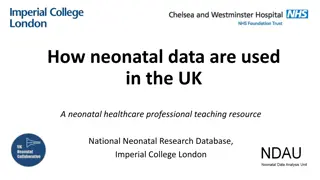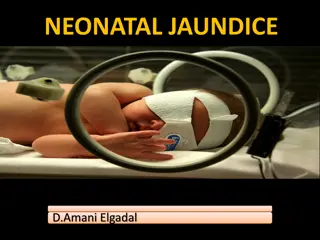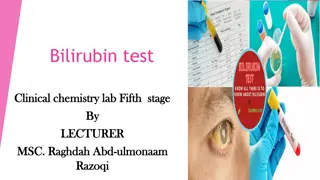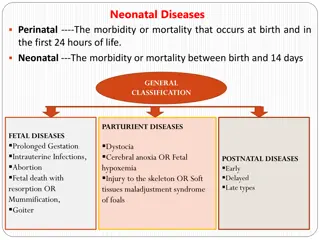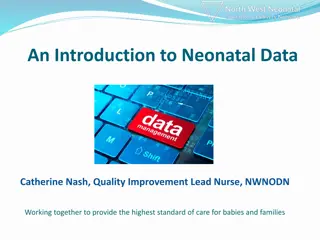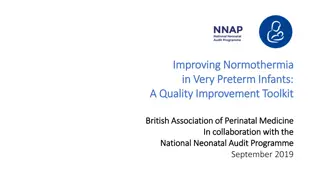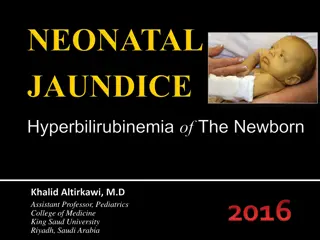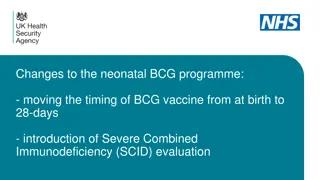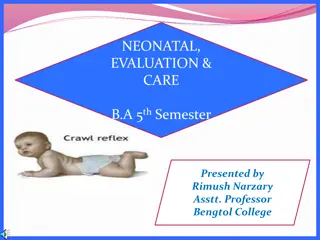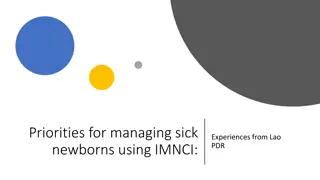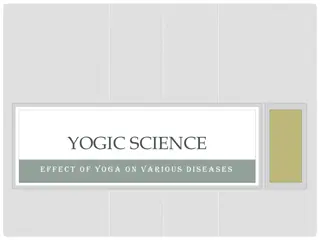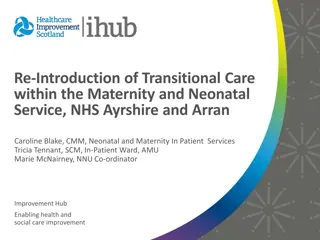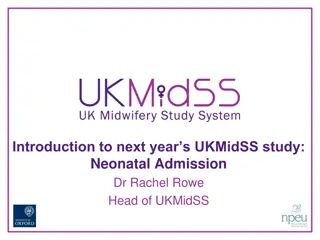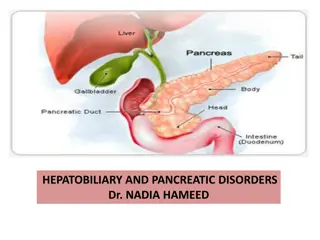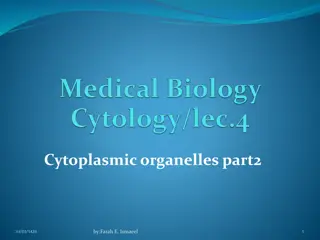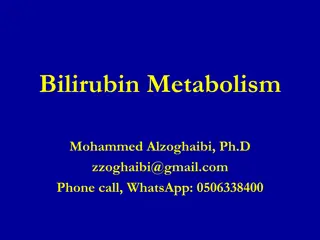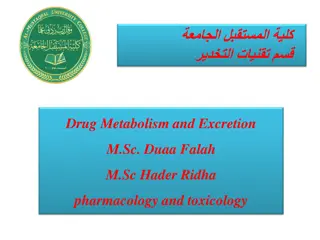Neonatal Jaundice - Bilirubin Metabolism & Management
Neonatal jaundice is common in infants and occurs due to increased serum bilirubin levels. This presentation covers bilirubin synthesis, transport, metabolism, and excretion, distinguishing between physiological and pathological jaundice, appropriate investigations for jaundiced infants, and strategies for prevention and treatment.
Uploaded on Mar 07, 2025 | 0 Views
Download Presentation

Please find below an Image/Link to download the presentation.
The content on the website is provided AS IS for your information and personal use only. It may not be sold, licensed, or shared on other websites without obtaining consent from the author.If you encounter any issues during the download, it is possible that the publisher has removed the file from their server.
You are allowed to download the files provided on this website for personal or commercial use, subject to the condition that they are used lawfully. All files are the property of their respective owners.
The content on the website is provided AS IS for your information and personal use only. It may not be sold, licensed, or shared on other websites without obtaining consent from the author.
E N D
Presentation Transcript
By the end of this presentation, the student should be able to: Describe bilirubin synthesis, transport, metabolism and excretion Distinguish between physiological and pathological jaundice in the newborn infant Mention the appropriate investigations for evaluating a jaundiced infant Mention the strategies for prevention and treatment of jaundice
A yellow discoloration of sclera & skin due to an increase in serum bilirubin Jaundice usually appears in the newborn infant when serum bilirubin concentration exceeds 85 mol/L Neonatal jaundice occurs in the majority of infants (>50% of the term and 80% of the preterm infants)
Synthesis From the breakdown of the heme molecule: The hemoglobin (80% ) Nonerytheroid heme (cytochrome, myoglobin..) (20%) The bilirubin produced is Unconjugated (indirect bilirubin) Unconjugated bilirubin is lipid soluble (pass through BBB) but not water soluble
Transport Unconjugated bilirubin is bound to albumin and carried via blood stream to hepatocytes Hepatocytes uptake this Bilirubin and transport it intracellular where it is metabolized
Conjugation Bilirubin is conjugated to glucoronic acid by the enzyme glucoronyl transferase Conjugated bilirubin (Direct bilirubin) is water- soluble (pass in urine) but not lipid soluble
Excretion Conjugated Bilirubin is excreted into bile In the intestine Flora changes it to stercobilinogen (Excreted in the stool) Small amount of stercobilinogen is absorbed and excreted in urine as urobilinogen Converted back to unconjugated bilirubin by the enzyme glucouronidase then reabsorbed and return back to liver (enterohepatic circulation)
Unconjugated hyperbilirubinemia: Defective conjugation Increased production (hemolysis) Increased bilirubin load (cephalhematoma) Other unidentified mechanisms
Defective conjugation Physiological Jaundice Congenital hypothyroidism Genetic enzyme deficiency (Crigler-Najjar syndrome)
Hemolysis Immune hemolysis Isoimmune (hemolytic disease of the newborn): Rh, ABO and minor groups. Autoimmune (Maternal autoantibodies): maternal SLE Non immune (Inherited hemolytic anemias) (G6PD,Spherocytosis, hemoglobinopathies) Others: Infections, sepsis, DIC, vit. E deficiency , Drugs
Increased bilirubin load Extravascular blood collection Polycythemia Dehydration Increased enterohepatic circulation Paralytic ileus Hirschsprung s disease Intestinal stenosis or atresia
Uncertain mechanisms Breast milk jaundice Breast feeding jaundice Some ethnic groups
Conjugated hyperbilirubinemia Decreased excretion rate Obstructive lesions Congenital biliary atresia Tumors or cyst Inspissated bile Metabolic and endocrine abnormalities Hypothyroidism Galactosemia
Mixed hyperbilirubinemia Hepatocyte abnormalities Sepsis Intrauterine infections Neonatal hepatitis Hepatitis viruses TORCH Idiopathic hepatitis Hypoxic insult
Severe hemolysis Obstructive lesion Biliary atresia Neonatal hepatitis Prematurity Infection Hypothyroidism Breast milk jaundice Crigler-Najjar Physiological Dehydration Sepsis Cephalohematoma Polycythemia Crigler-Najjar
At Birth Or Within 24h Within The 1st Week Hemolysis (Blood group incompatibility) Congenital infection (TORCH) Sepsis Physiological jaundice Congenital infection (TORCH) Sepsis Concealed hemorrhage Crigler-Najjar syndrome
Persistent After The 2nd Week After The First Week Sepsis Hepatitis Biliary atresia Breast milk jaundice Hypothyroidism Galactosemia Inherited hemolytic anemia Neonatal hepatitis Biliary atresia Inspissated bile syndrome
Caused by crossing of unconjugated bilirubin the BBB to the brain. The level at which brain injury happens depends on Maturity/Postnatal age Binding capacity in the blood (Albumin concentration) Associated risk factors (acidosis, infection, asphyxia ) Kernicterus: Yellowish staining of the brain tissue by bilirubin deposition associated with evidence of neuronal injury Mostly affects basal ganglia, brain stem and cerebellar nuclei and anterior horn cells
Acute Encephalopathy Chronic Encephalopathy Three phases Hypotonia, lethargy, high pitched cry and poor sucking Extensors hypertonia, opithotonus, fever and seizures Hypotonia replaces hypertonia in a week Death may occur up the second phase Athetosis Sensorineural hearing deficit Limited upward gaze Dental dysplasia Intellectual deficit
Due to: 1. Increased synthesis of bilirubin caused by the excessive RBCs load after delivery 2. Relative immaturity of the liver glucoronyl transferase Onset usually on 2nd-3rd day Disappear around day 7-10 Infant is usually healthy
Exacerbating Factors Prematurity Polcythaemia Dehydration Breast feeding (usually higher by 50-65 mol/L than formula fed) Laboratory Rate of accumulation is less than 85 mol/L/day
Treatment: Maintain sufficient feeding Serial measurements of serum bilirubin Look for pathological causes if bilirubin level exceeds the expected for age Phototherapy if needed
Indicated if bilirubin level exceeds a set point Exposure of infant to light with wave length around 450nm Isomerization of bilirubin to nontoxic water soluble form Eyes should be protected Control for temperature and fluid balance is important
Physiological Pathological 2nd-3rd day of life in term infants Onset At any time Level of S. Bilirubin Usually lower Usually higher Type of Bilirubin Unconjugated Any Slow increase (usually <85 mol/L/24h) May be faster (usually >85 mol/L/24h) Rate of increase Shorter Duration May be longer (usually 7-10 days in the term and 14days in Preterm) Physical Exam and Lab. investigations Normal, healthy infant Abnormal
Conjugated hyperbilirubineamia beyound 2nd week of life Disappears within 2 days if breast feeding is discontinued May take up to 3 months to resolve completely Due to (?) Postulated substance in human milk that inhibits enzymatic activity of glucoronyl transferase Other pathologies need to be excluded Treatment: Temporary stoppage of breast feeding (not recommended) Reassurance and follow up
May be related to decreased amount of milk consumed by the infant (breastfeeding failure ) More effective nursing may prevent early starvation in breastfed newborns and reduce the incidence of this type of jaundice
Is the hemolysis resulting from Rh or ABO incompatibility between the mother and the infant
Rh isoimmunization Mother is Rh ve and the fetus is Rh+ve First pregnancy usually goes with no fetal problems Mother is sensitized by fetal Rh+ve RBCs Antibodies to Rh+ve RBCs is formed and it is transmitted to the fetus during second pregnancy ~ 1/100 pregnancies and not in every Rh-ve mother May be prevented by AntiD administred to the mother
ABO incompatibility (milder disease) The anti-A or Anti-B hemolysins (antibodies) present in a mother with blood group O is transferred to the fetus of A or B blood group This results in hemolysis (most transferred antibodies can be neutralized by the baby) 1 in every 200 births The first baby can be affected
Severe hemolysis manifestations Hydrops fetalis The most severe form Often still birth with severe anemia and massive edema and ascitis Icterus gravis neonatorum Jaundice in the first 24hr, not at birth Variable degree of hemolytic anemia Hepatosplenomegaly Gradual onset of anemia and slight jaundice in the first few days or weeks
Prevention Anti-D within 72 hrs after delivery of Rh+ve child or abortion. Management: Life support Establish diagnosis Early phototherapy Transfusion to restore normal hemoglobin level Prevent dangerous rise of bilirubin hoping to prevent neurotoxicity (Exchange transfusion if needed)
Indicated in Kernictrus Cord bilirubin >85 mol/L or Cord hemoglobin <100 g/L Rate of bilirubin rise > 8.5 mol/L/hour Unconjugated bilirubin level > 340 mol/L at any age (at a lower level in presence of risk factor as prematurity, sepsis) Double volume exchange transfusion
Always pathological Direct bilirubin >34 mol/L Evaluation Serum bilirubin Liver function tests Cultures (blood, urine, .) Abdominal ultra sound Isotopic scan (scintegraphy) Liver biopsy
Neonatal hepatitis Biliary atresia Stool color Intermittent pale Persistent pale Serum Bilirubin Biphasic Mainly conjugated ALT, AST Marked increase Mild increase Alk. Phosphatase Mild increase Marked increase Sluggish uptake, Uptake is intact but excretion into intestine is absent Liver scintegraphy Eventual excretion of isotope Inflammatory Infiltration, distorted lobular architecture and focal necrosis Intact lobular architecture, bile ductular proliferation or paucity, perilobular edema and fibrosis Liver biopsy
Treatment of chronic cholestasis Treatment of the cause Supportive Fat soluble vitamins Use of medium chain triglycerides-containing formula Attention to micronutrients as Ca, Ph, Zinc Surgical interference Billiary atresia: Kasai operation , Liver transplantation
THANK YOU


